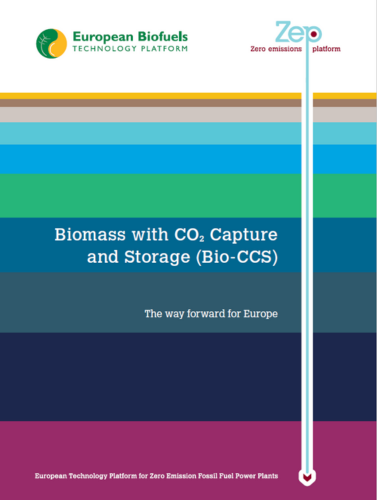Bio-CCS: The way forward for Europe
About the report
Bio-CCS combines sustainable biomass conversion with CO2 Capture and Storage (CCS) – e.g., in biofuels and bioenergy production – and is already being deployed at industrial scale in the U.S. Use of biofuels and bioenergy is steadily increasing in the European Union (EU) due to targets for renewable energy sources and certain biofuels production routes could provide “low-hanging fruits” for early, low-cost CCS deployment.
A recent study indicated that, globally, Bio-CCS could remove 10 billion tonnes of CO2 from the atmosphere every year by 2050 using available sustainable biomass – equivalent to a third of all current global energy-related emissions. In Europe, Bio-CCS could remove 800 million tonnes of CO2 from the atmosphere every year by 2050 using available sustainable biomass – equivalent to over 50% of current emissions from the EU power sector. This is in addition to any emissions reductions achieved by replacing fossil fuels with biomass.
Bio-CCS could ultimately result in industry sectors whose overall emissions are below zero, which could then offset emissions in other sectors where reductions are more difficult to attain.
Key conclusions
- Recent research indicates that more powerful technologies are now needed to keep global
warming below 2°C1 – and avoid irreversible climate change. This is echoed by warnings from both
the United Nations Framework Convention on Climate Change (UNFCCC) and the International
Energy Agency (IEA). - There is therefore an urgent need for carbon-negative solutions such as Bio-CCS – the only large-scale technology that can remove CO2 from the atmosphere. Bio-CCS combines sustainable
biomass conversion with CO2 Capture and Storage (CCS) – e.g., in biofuels and bioenergy
production – and is already being deployed at industrial scale in the U.S.2. - Use of biofuels and bioenergy is steadily increasing in the European Union (EU) due to targets for
renewable energy sources and certain biofuels production routes could provide “low-hanging
fruits” for early, low-cost CCS deployment. - A recent study indicated that, globally, Bio-CCS could remove 10 billion tonnes of CO2 from the
atmosphere every year by 20503 using available sustainable biomass – equivalent to a third of all
current global energy-related emissions. In Europe, Bio-CCS could remove 800 million tonnes of
CO2 from the atmosphere every year by 20503 using available sustainable biomass – equivalent
to over 50% of current emissions from the EU power sector. This is in addition to any emissions
reductions achieved by replacing fossil fuels with biomass. - Bio-CCS could ultimately result in industry sectors whose overall emissions are below zero which could then offset emissions in other sectors where reductions are more difficult to attain.
The following actions are therefore urgently required at EU level:
- As for other low-carbon technologies, establish economic incentives to enable the large-scale
deployment of Bio-CCS – in particular, reward negative emissions via the capture and storage
of biogenic CO2 under the EU Emissions Trading Scheme, in the same way as for fossil CCS. - Identify and incentivise the clustering of small-scale biogenic emission sources with other
emission sources to achieve economies of scale for CO2 transport and storage. - Undertake R&D to determine the costs of the various Bio-CCS routes, including additional
costs induced by corrosion and other technology challenges when co-firing with high biomass
percentages in existing boilers. - Establish dedicated funding for R&D and pilot projects to further develop and prove advanced
technologies. - Address issues specific to Bio-CCS deployment (e.g., accelerate deployment of advanced
biomass conversion processes) and establish an EU roadmap towards 2050. - In addition, establish additional non-ETS measures to enable EU CCS demonstration projects
to take Final Investment Decision (FID) and provide security for long-term investment
